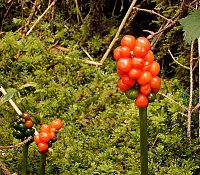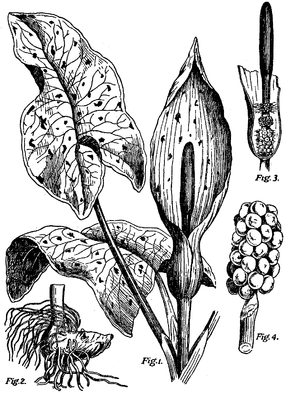- Arum maculatum
-
Arum maculatum 
Lords and Ladies (Arum maculatum) is a common arum in British woodlands Scientific classification Kingdom: Plantae (unranked): Angiosperms (unranked): Monocots Order: Alismatales Family: Araceae[also lily] Subfamily: Aroideae Tribe: Areae Genus: Arum Species: A. maculatum Binomial name Arum maculatum
L.Arum maculatum is a common woodland plant species of the Araceae family. It is widespread across temperate northern Europe and is known by an abundance of common names including Wild arum, Lords and Ladies, Devils and Angels, Cows and Bulls, Cuckoo-Pint, Adam and Eve, Bobbins, Naked Boys, Starch-Root and Wake Robin.
Contents
Description
The purple spotted leaves of Arum maculatum appear in the spring (April–May) followed by the flowers borne on a poker shaped inflorescence called a spadix. The purple spadix is partially enclosed in a pale green spathe or leaf-like hood. The flowers are hidden from sight, clustered at the base of the spadix with a ring of female flowers at the bottom and a ring of male flowers above them.
Above the male flowers is a ring of hairs forming an insect trap. Insects, especially Psychoda spp., attracted to the spadix by its faecal odour and a temperature up to 15 degrees celsius warmer than the ambient temperature,[1] are trapped beneath the ring of hairs and are dusted with pollen by the male flowers before escaping and carrying the pollen to the spadices of other plants, where they pollinate the female flowers.The spadix may also (see the picture) be yellow, but purple is the more common.
In autumn the lower ring of (female) flowers forms a cluster of bright red berries which remain after the spathe and other leaves have withered away. These attractive red to orange berries are extremely poisonous. The berries contain oxalates of saponins which have needle-shaped crystals which irritate the skin, mouth, tongue, and throat, and result in swelling of throat, difficulty breathing, burning pain, and upset stomach. However, their acrid taste coupled with the almost immediate tingling sensation in the mouth when consumed mean that large amounts are rarely taken and serious harm is unusual. It is one of the most common causes of accidental plant poisoning based on attendance at hospital A & E departments.[2]
The root-tube may be very big and is used to store starch. In mature specimens the tuber may be as much as 400 mm below ground level.
All parts of the plant can produce allergic reactions in many people and the plant should be handled with care. Many small rodents appear to find the spadix particularly attractive and it is common to find examples of the plant with much of the spadix eaten away. The spadix produces heat and probably scent as the flowers mature and it may be this that attracts the rodents.
Arum maculatum is also known as the cuckoo pint in the British Isles and is named thus in Nicholas Culpepers' famous 16th Century herbal. This is a name it shares with Arum italicum (Italian Lords-and-Ladies) - the other native British Arum.
Uses
Culinary
The root of the cuckoo pint, when roasted well, is edible and when ground was once traded under the name of Portland sago. It was used like salop or salep (a working class drink popular before the introduction of tea or coffee). It was also used as a substitute for arrowroot. If prepared incorrectly, it can be highly toxic so should be prepared with due diligence and caution.
Cultivated
Arum maculatum is cultivated as an ornamental plant in traditional and woodland shade gardens. The cluster of bright red berries standing alone without foliage can be a striking landscape accent. The mottled and variegated leaf patterns can add bright interest in darker habitats.
References
- "Arum maculatum". Integrated Taxonomic Information System. http://www.itis.gov/servlet/SingleRpt/SingleRpt?search_topic=TSN&search_value=185363. Retrieved September 25, 2006.
- ^ . JSTOR 90493.
- ^ Robertson, John 2009 (2009). "Arum maculatum, cuckoopint, lords and ladies". The Poison Garden. http://www.thepoisongarden.co.uk/atoz/arum_maculatum.htm. Retrieved 2009-08-01.
External links
Categories:- Araceae
- Flora of Europe
- Invasive plant species
- Invasive plant species in the United States
- Medicinal plants
- Garden plants of Europe
Wikimedia Foundation. 2010.


